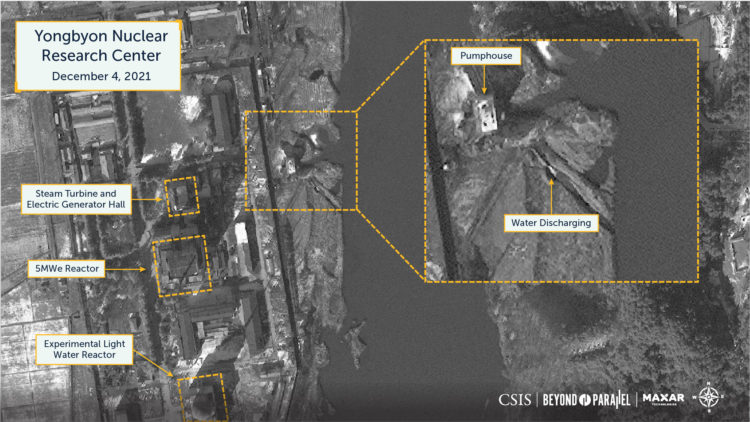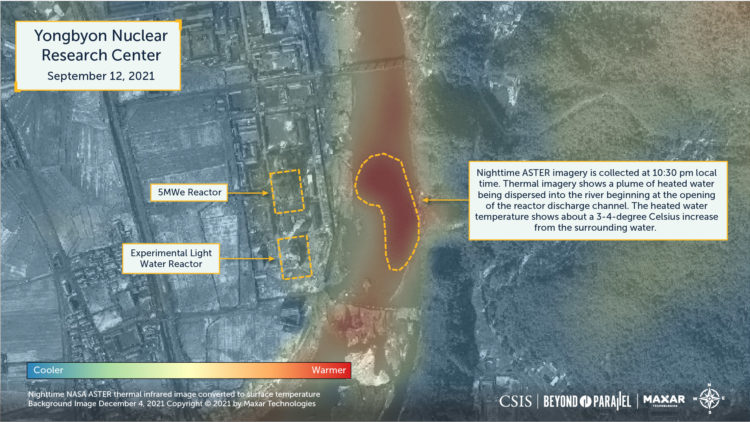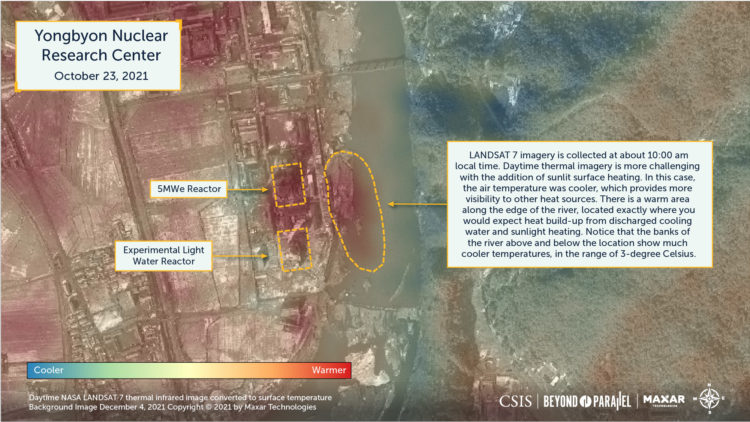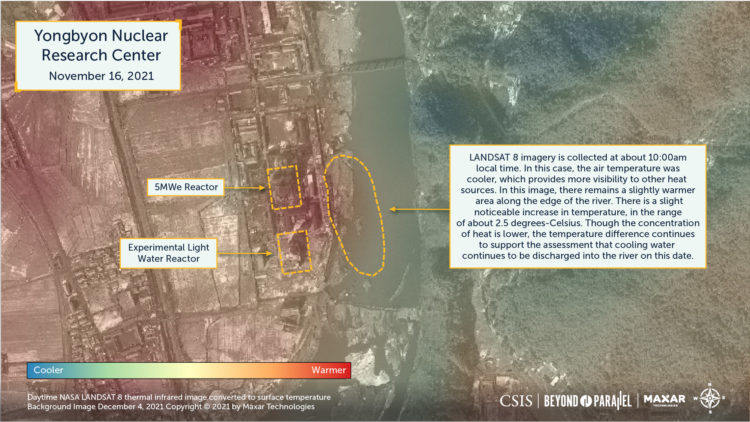
Thermal Imagery Analysis of Yongbyon
Key Findings
- ASTER, LANDSAT 7, and LANDSAT 8 thermal infrared imagery from September 12, October 23, and November 16 show warm water being discharged from the cooling system of the 5MWe reactor and that the reactor is in operation.
- The fuel rods irradiated during the reactor’s operations will most likely be subsequently sent to the Radiochemical Laboratory for reprocessing to provide additional plutonium designed to expand North Korea’s inventory of nuclear weapons.
- Multispectral and infrared satellite imagery not only supports but also dramatically illustrates and expands upon the conclusions in Beyond Parallel’s March 30, 2021 and April 15, 2021 reports.
As part of continuing coverage of North Korea’s weapons of mass destruction, Beyond Parallel has undertaken a new thermal infrared analysis of the 5MWe and Experimental Light Water reactors at the Yongbyon Nuclear Research Center using NASA ASTER, LANDSAT 7, and LANDSAT 8 thermal infrared imagery. This analysis covers the period from September through November 2021 and updates Beyond Parallel’s previous thermal infrared study of the facility from earlier this year, focusing upon the operations of the 5MWe reactor.1

The thermal infrared imagery from September through November 2021 provides clear and conclusive evidence that the 5MWe reactor at Yongbyon is operating. During the past several months, water discharge from the reactor and probable steam exhaust from the steam turbine and electric generator hall has been observed in visible satellite imagery. However, through the use of thermal imagery, it can be determined that the water that is being discharged is indeed warm water discharge from the reactor’s cooling system.
Imagery from September 12th, October 23rd, and November 16th of this year show continued and similar patterns of warm water discharge into the Kuryong-gang (Kuryong River). Temperature variations of up to 4 degrees Celsius are present in the river where the discharged water disperses in the river. The warmest temperatures of the dispersal pattern are found near the mouth of the water discharge channel outlet and reveal clear indications that the reactor is in operation.

September 12th ASTER nighttime imagery illustrates the thermal pattern of the discharge most clearly. The image was collected at about 10:30 pm local time and shows the sharpest contrast between the cool nighttime land surface and the warmer water pattern in the river. The October 23rd LANDSAT 7 image was collected at about 10:00 am local time. October 23rd was a cooler day temperature-wise and helped to highlight the warm area in the river due to ongoing warm water discharge. The November 16th LANDSAT 8 image was also collected at about 10:00 am local time. This image again shows a concentration of warm thermal pattern around the water discharge area and in the river, indicating warm water is being dumped into the river.


For the same period under study, the IRT-DPRK reactor showed no obvious thermal patterns that would indicate operations. The operational status of the Radiochemistry Laboratory is somewhat more difficult to ascertain in the thermal imagery alone. For certain, the Radiochemistry Laboratory and the associated thermal plant are cold in the nighttime September 12th image. For the two daytime images on October 23rd and November 16th it is more challenging to assess operational status based upon thermal patterns alone as the roofs of both complexes are dark and they are in a relatively sheltered location, so they absorb and radiate a lot of daily heat. When, however, combined with more traditional color imagery during that same period there are no strong indications of any significant activity at the Radiochemistry Laboratory or thermal plant.
Beyond Parallel will continue to monitor activity at the Yongbyon Nuclear Research Center and provide additional thermal infrared reports as available imagery and activity warrant.
References
- For an explanation of the methodology used in preparing this report please see our previous study at https://beyondparallel.csis.org/thermal-imagery-indicates-activity-at-yongbyon-nuclear-reprocessing-facilities/. ↩
